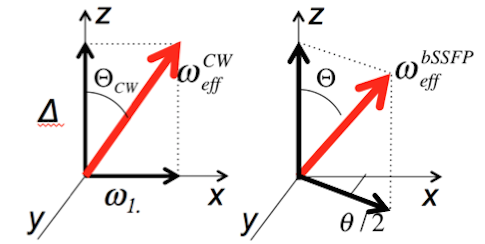Standard detection of CEST effect is based on the RF saturation of the exchanging group. This may not be the most sensitive, specific, or efficient way to detect the exchange process with MRI. Thus, we are exploring other means of excitation and detection.
For example, in the approach of On resonance PARamagnetic CHemical Exchange Effects (OPARACHEE), RF pulses are applied on-resonance with water to detect PARAmagnetic Chemical Exchange Saturation Transfer (PARACEST) agents. Another example is the generation of positive CEST contrast (pCEST), using inversion pulse and exploring differences in the off-resonance spin-lock relaxation times.
Currently, we are investigating the properties of balanced steady-state free precession (bSSFF or trueFISP). The method has inherent properties similar to continuous-wave saturation and can be used to detect exchange.
